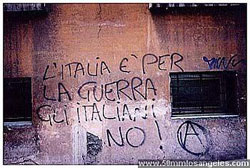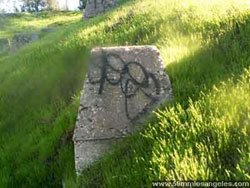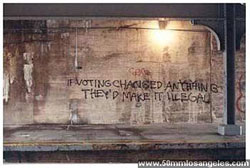|
Why Do You Write? A Look Into the Motives Behind Graffiti Art
Story by Gabe the Saint
50mm staff writer
Graffiti artists often fumble when posed with the question- “why do you write?†The answer to that question is indisputably subjective. Nonetheless, we can affirm that there are several components that motivate and bond Graffiti artists, some are obvious such as artistic expression, and recognition. There are the superficial reasons for instance riding the bandwagon or trying to fit the trend. However, there is one aspect that is overlooked, which is crucial and is perhaps the adhesive that conjoins not only regional fame Graffiti artists, but also all artists that choose Graffiti strictly to deliver political messages. Yes Politics. I argue that the underlying force that fuels, the under current, the bonding agent and the essence of the Graffiti Culture is politics.
In order to distinguish the political component within the Graffiti culture we must look at the general answers that Graff artists give when asked the purpose for them choosing to do Graffiti. The most popular answer given is perhaps artistic expression. If expression is their motive, then why not choose conventional art forms such as painting, drawing, etc…? Why take the risk of being jailed or ostracized as a “vandal†and your art never taken seriously or into consideration? Expression is simply a façade for deeper issues that are misinterpreted by the artist. By a façade I mean that the artist, usually a young person, does not realize the social political problems that plague his world and the frustrations that they cause which inclines him/her to take revenge on society(1). Let’s consider a few of examples, inadequate public art programs, public school art programs, and cuts for the arts. Earlier this year Governor Schwarzenegger introduced his new budget for California, which slashes 80 million dollars from primarily three areas, Resources, Health services, and higher education. 1 million dollars was cut from the California Art’s Council budget. To add more weight to the problem, Public school administrators are forced to reconfigure their budgets and the arts are usually on top of their list for cuts. So what happens to the child with artistic inclination and no means of expression? I think that we all know the answer to that question. This is merely one result of the many caused by government proposals and legislation which creates contempt and nihilism amongst the youth, encouraging them to express their resentment in the form of Graffiti. Let us move on to the second most popular reply to the question(2).
Recognition is a loaded word that in actuality means Egoism, fame, and frustration. Why frustration? Frustration towards our “democratic†government’s single voice. Frustration towards the unofficial branch of the government-the corporation. The corporation with its infinite bank account and eagerness to sell its product floods our social landscape pushing their products onto us- logos, billboards, trailers, public transportation, etc. The American on average perceives nearly 1500 images from the time that they wake up to the time they go to bed. In one year, that equals 534,000 images. Not only are advertisements over stimulating, they also drown out the voices of the public as well and create frustration and motivation for people to do Graffiti. Politics is an inherent component of Graff art, which links all Graff, hence creating a subculture. The point is obvious, and no need to further explain, I would only be regurgitating. Now I want
to make clear the connection between so-called fame Graffiti and Graffiti that overtly delivers a political message. It is not unique to the United States that Graff is used as a means of political expression. In South Africa during Apartheid, it was not uncommon to for black Africans to mark the walls with statements such as “We are humans as well!†In Tijuana, Mexico, the names of individuals that attempted to make the deadly voyage to a “better life†are marked by white painted crosses, which bear their names on the corrugated steel fence that runs along the side of the deadly waterway. In Iraq the walls read “Americans out.†On the Gaza Strip, Palestinians often make their plea to the world and to the Israeli government to depart from the occupied territories. The Catholics in Ireland, the Basque in Spain, Brazilian children, Argentine mothers looking for their abducted children, victims of the drug cartel in Columbia, the list is endless. Comparable to fame Graffiti, there is a political component and a need to express frustration, which is psychological. What differentiates the two forms is that one is explicit and the other one tends to mask it’s intentions. It s not difficult to discern that politics are an inherent component of Graffiti. Artistic expression and recognition are just facades of deeper political agendas that set in motion and form the Graff subculture. Part of this subculture includes other more overt political Graff outside the
United States. The overarching idea is that regardless why, where, when and how you write you are part of a powerful subculture. Oh yeah, one more thing, Fuck Bush!
1 My experience has led me to believe that Graffiti artists usually begin tagging with the intention of taking revenge on society and eventually evolve and begin to appreciate the positive qualities of the genre. That is my intention of using revenge in this context. 2 I mentioned health program cuts. Consider the feelings of an adolescent watching his family, peers or people in his /her community suffering from illnesses because they cannot afford medical attention or medication. I think that these are valid grounds for the adolescent to feel frustration, and anger towards the system/society.
|
|




|







